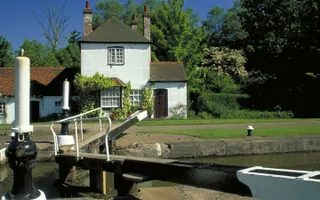Hatton’s flight of 21 locks provides an excellent example of how our canal heritage has adapted to meet the needs of a changing society.
From highways of the Industrial Revolution, our canals have become a much valued recreational resource and a vital green corridor for wildlife.
Today, Hatton Locks is found on a stretch of waterway named the Grand Union Canal, but when it opened in December 1799, this was the Warwick & Birmingham Canal, built to carry locally mined coal to the power stations and factories of the Black Country. It was also a vital trade link in a chain of waterways connecting London with the Midlands.
Commercial canal carrying under threat
This chain was formed of eight different canals, each owned by a different Canal Company. However, in 1929, when commercial canal carrying was under serious threat from road and rail transport, one company, the Grand Union Canal Company, took over the entire route and re-named it the Grand Union Canal.
Making the canal pay
The Company immediately embarked on a major modernisation programme in a bid to make the canal pay. Locks on narrow sections of the route, like the ones here at Hatton, were widened to accommodate 14-foot wide boats, or two narrowboats side by side. Twice as much cargo could pass through each lock – a welcome improvement for the boaters who had to work their heavy boats laden with coal, sugar, tea and spices through what they called the 'Stairway to Heaven'. It is believed that this name refers to the relief felt by boaters on reaching the top of the steep Hatton lock flight, after which it was easier going to Camphill where their wages were waiting at the Grand Union Canal Carrying Company offices.
Concrete – a revolutionary new material
At Hatton, this widening work started in 1932 and involved the use of concrete, a revolutionary new material in canal building. After two years, with over 1,000 men working on the project, the new concrete locks and bridges were officially opened by HRH the Duke of Kent. You can still see some of the old brick-built narrow lock chambers beside some of the 'new' wide locks. You can also see an old working boat, or 'maintenance flat', supporting a 'piling rig'. This was used to hammer timber or concrete piles into the sides of the canal to protect them from water erosion, or wayward boats!
History brought to life
The process of modernisation to meet the evolving needs of canal users has been ongoing here at Hatton. The old wharf and maintenance yard, where carpenters and blacksmiths made heavy oak lock gates, have been restored to create offices and a heritage skills training centre. The old stable block, where canal horses bedded down for the night, is now a popular café.
But the ghosts of times past remain here as well. You can often see a pair of restored working boats called 'Malus' and 'Scorpio', that once worked this route, moored alongside Hatton Wharf. They were restored as part of a Heritage Lottery Funded Working Boats Project. A recent Heritage Lottery funded project has made some of the site's hidden history available to visitors through information panels, leaflets, a family wildlife trail along the lock flight, education packs and picnic benches.
It takes time and funding to keep history alive at Hatton Locks. Your support makes it possible.






